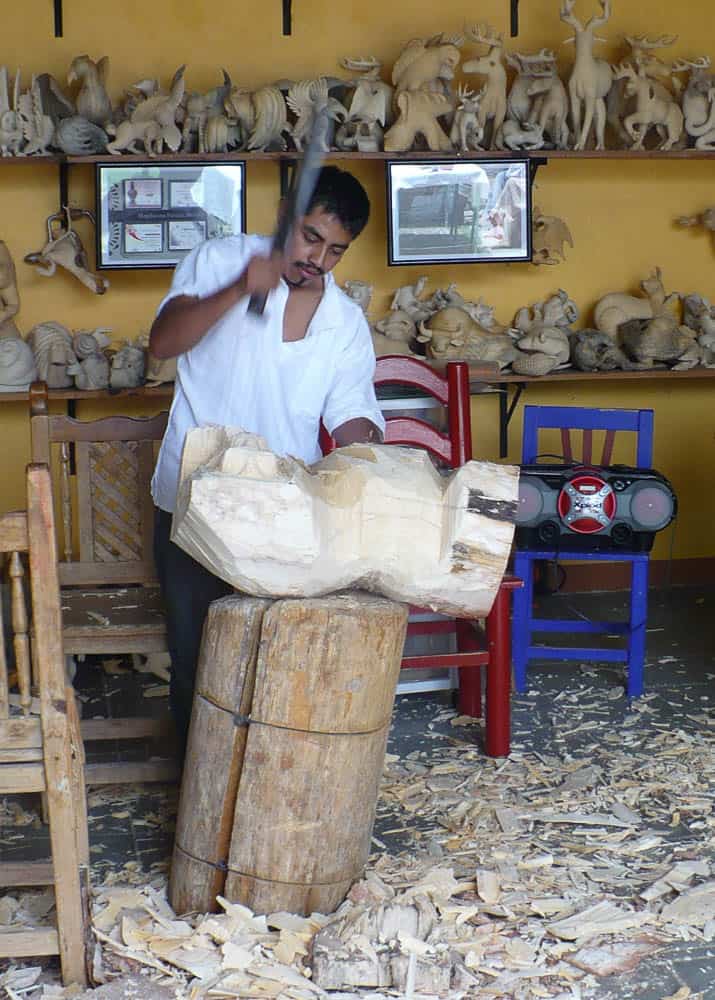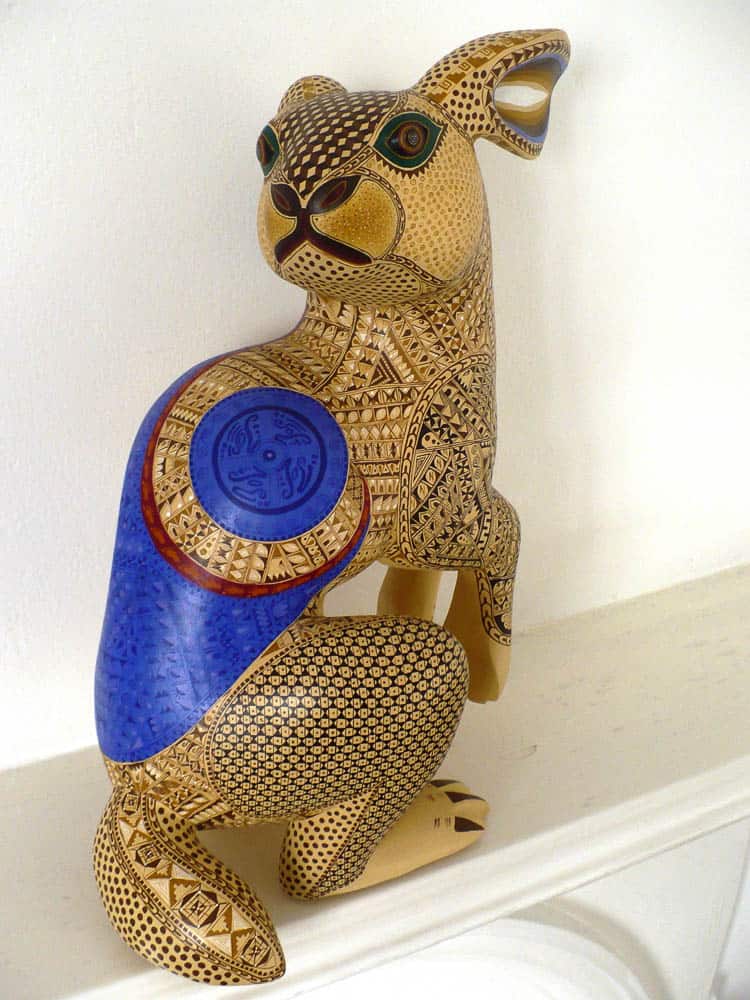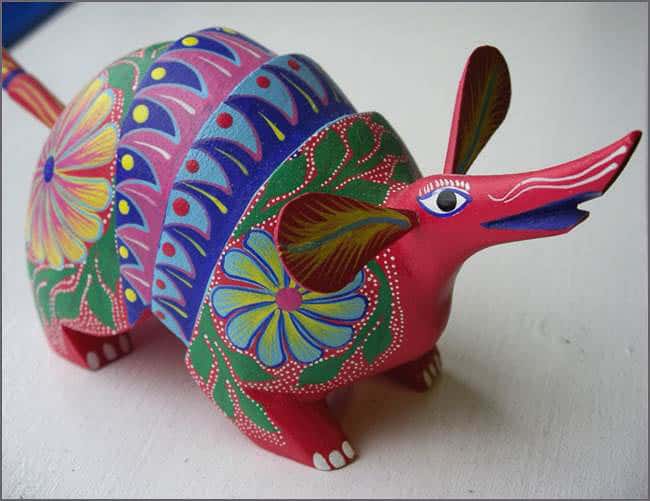Sitting on my windowsill is a carving of a rabbit from the town of San Martín Tilcajete, in Mexico, where the vast majority of families make their living by producing Oaxacan woodcarvings, or alebrijes, which they sell to tourists and collectors of ethnic art. Picking the rabbit up, I think that I probably should move it elsewhere, lest the bright rays of the sun fade its vibrant indigos and its earthy browns, which remind me of corn tortillas and chocolate, staples of the region where the rabbit was made. I turn it over, noting the balance of the piece: its weight and solidity offset by the delicate carving and the fine paintwork that form lines of geometric patterns, cloaking the rabbit’s back and haunches. On the bottom of its left foot, I see a list of information: title (Conejo Volteando # 5), materials (copal wood with pigments and minerals), place (San Martín Tilcajete) and author… yet seeing the author’s name inscribed on the rabbit brings to my mind the many other people whose names are not listed here, yet are also its makers.
The question of who authors ethnic arts and crafts is a subject that emerged quite forcefully in my ethnographic research with contemporary Oaxacan woodcarvers. Oaxacan woodcarvings are brightly painted figures, often of animals or popular Mexican folk characters, which can be found in galleries and stores throughout Mexico and the United States. Visiting the workshops where they are made is a popular activity for Mexican and foreign visitors to Oaxaca, a small city whose colonial centre and ancient Zapotec ruins attract the kind of visitors who want to immerse themselves in local culture. The carvings were invented by Manuel Jiménez in the village of San Antonio Arrazola in the late 1950s. By the 1990s, woodcarving was established as a major source of income for many families in San Martín, often supplementing uncertain economic returns from agriculture and migrant remittances.
As part of my research, I spent a large amount of time observing different kinds of woodcarving workshops. One of the most interesting was a large workshop, owned by a family that has become very successful in recent years. Even during the off-season, when visitors to San Martín were few and far between, they welcomed tourists and collectors many times a week, who came to see their exciting and informative demonstrations. As their business has grown very rapidly in the past fifteen years, they now employ many neighbours and members of their extended family, who work carving and painting in their unique “house-style,” which they developed over many years of hard work and experimentation.

One afternoon, I was observing a group of American tourists who were visiting the workshop. After they saw the demonstration of the pigments and painting techniques, the group moved to the back of the compound to see a carving demonstration. However, one young woman hung back and was looking closely at a carving that Citlali (pseudonym), a painter in her early twenties, was just finishing. Although the woman seemed interested in the piece, she asked Citlali in Spanish how long she had worked there for. Citlali answered “two years,” and looked up, smiling. Dropping her voice, the young woman then asked, “and do you ever get to sign your own work, or is it always signed by the jefes (bosses)?” Citlali’s smile flickered for a moment, and then she answered, “We are all people of this workshop, and this is the name of the workshop, so that is our signature.”
As a social anthropologist, my job is not only to trace the history and cultural significance of art forms like Oaxacan woodcarvings, but also to analyse how particular practices and beliefs relate to issues of power and authority. Authorship can be understood as the perceived unbreakable link between an object and the person who made it. To artists, collectors and viewers of artworks, this bond often seems natural: while an artwork may be sold, stolen or given away, it remains an artefact of the artist and her life, and she remains its creator. However, from anthropological or sociological points of view, authorship is also an ideology. It is a system that prioritizes some individuals’ connections to artworks at the expense of broader, oftentimes collective, relationships between objects and people. As authorship has also emerged as a legal condition that bestows particular rights—in particular, the right to profit from the work – the question of legitimate authorship is not only one of recognition, but can also directly impact people’s economic well-being.
The tensions that can emerge from the designation of authors is particularly evident in the case of ethnic arts and crafts like Oaxacan woodcarvings. Rather than the outputs of individual artists, ethnic arts are created in the styles, content and forms that are deemed to be characteristic of the culture or group that makes them. However, as such ethnic arts become commodities that circulate within globalised art markets dominated by Western or Euro-American values, the collective nature of cultural practices is increasingly devalued. In order to compete in such markets, artisans must distinguish their work from that of their neighbours; in so doing, they inevitably also assert the individual authorship of their innovations (particularly when the work of certain artisans is considered very valuable by collectors).
As I have written about elsewhere, the circulation of ethnic arts in global markets also exposes artisans to risks of the replication and copying of their work by individuals or companies that have no relationship with them. In such cases, artisans often appeal to intellectual or cultural property legislation for protection. However, in practice, these legal regimes of authorship rarely offer solutions to the problem of copying.
The challenge raised by the transition from collective to individual cultural production is compounded in contexts where ethnic arts and crafts are still made collectively, in family workshops or through larger relations of employment. Although Citlali earns a wage and develops her painting skills through her work, all of the recognition, reputation and profit go to her employers. Further, she is effectively prevented from developing her own style or “name” in the woodcarving market: all of the work she does, even her own innovations within the “house style” become incorporated into the recognized style of her jefes. In a workshop where many people’s time, skill and creativity come together to transform rough copal branches into delightful Oaxacan woodcarvings, who is legitimately an author becomes a difficult empirical and ethical question to answer.
Further reading
Chibnik, Michael 2003. Crafting Tradition: The Making and Marketing of Oaxacan Woodcarvings. Austin: University of Texas Press.
Coombe, Rosemary 1998. The Cultural Life of Intellectual Property. Durham: Duke University Press.
Geismar, Haidy 2013. Treasured Possessions: Indigenous Interventions into Cultural and Intellectual Property. Durham: Duke University Press.
Wood, William W. 2008. Made in Mexico: Zapotec Weavers and the Global Ethnic Art Market. Bloomington: Indiana University Press.
Author
 Alanna Cant is a social anthropologist who has studied and worked in Canada, Germany, Norway and the United Kingdom. She is currently a postdoctoral research fellow in anthropology at the University of Kent, UK, where she holds a Marie Skłodowska-Curie grant from the European Commission. Her research is about art, aesthetics, material culture and religion in Oaxaca, Mexico; themes that continue in her current work on the restoration of a 16th-century Dominican monastery in a rural and predominantly Catholic Oaxacan community. The research for this essay was supported by the Emslie Horniman Fund of the Royal Anthropological Institute of Great Britain and Ireland, and the London School of Economics, where she completed her PhD in 2012. Cant has published many articles and chapters on Oaxacan woodcarving in scholarly journals, which can be found at www.alannacant.com. Her book, The Value of Aesthetics: Oaxacan Woodcarvers in Global Economies of Culture will be published in 2019 by the University of Texas Press.
Alanna Cant is a social anthropologist who has studied and worked in Canada, Germany, Norway and the United Kingdom. She is currently a postdoctoral research fellow in anthropology at the University of Kent, UK, where she holds a Marie Skłodowska-Curie grant from the European Commission. Her research is about art, aesthetics, material culture and religion in Oaxaca, Mexico; themes that continue in her current work on the restoration of a 16th-century Dominican monastery in a rural and predominantly Catholic Oaxacan community. The research for this essay was supported by the Emslie Horniman Fund of the Royal Anthropological Institute of Great Britain and Ireland, and the London School of Economics, where she completed her PhD in 2012. Cant has published many articles and chapters on Oaxacan woodcarving in scholarly journals, which can be found at www.alannacant.com. Her book, The Value of Aesthetics: Oaxacan Woodcarvers in Global Economies of Culture will be published in 2019 by the University of Texas Press.



